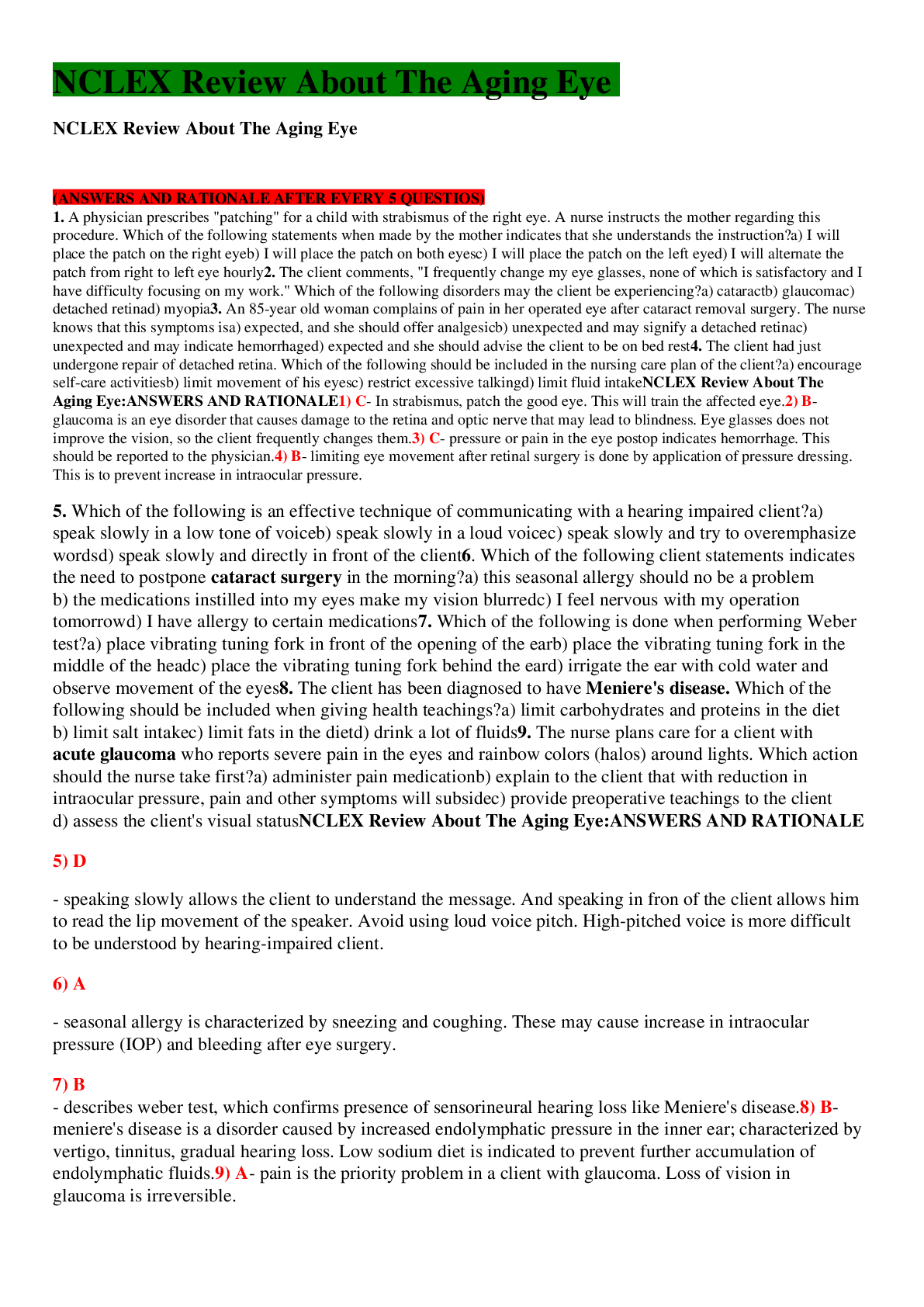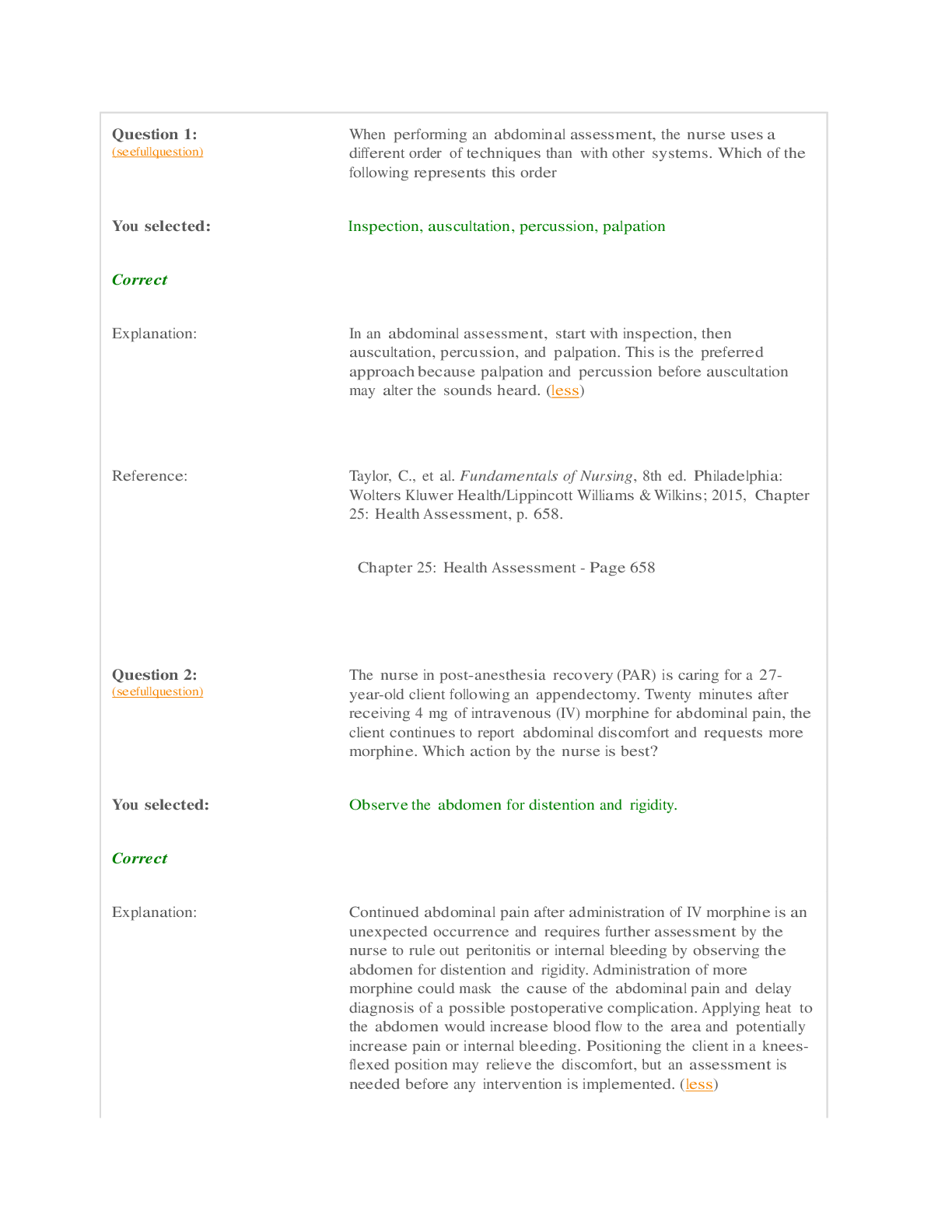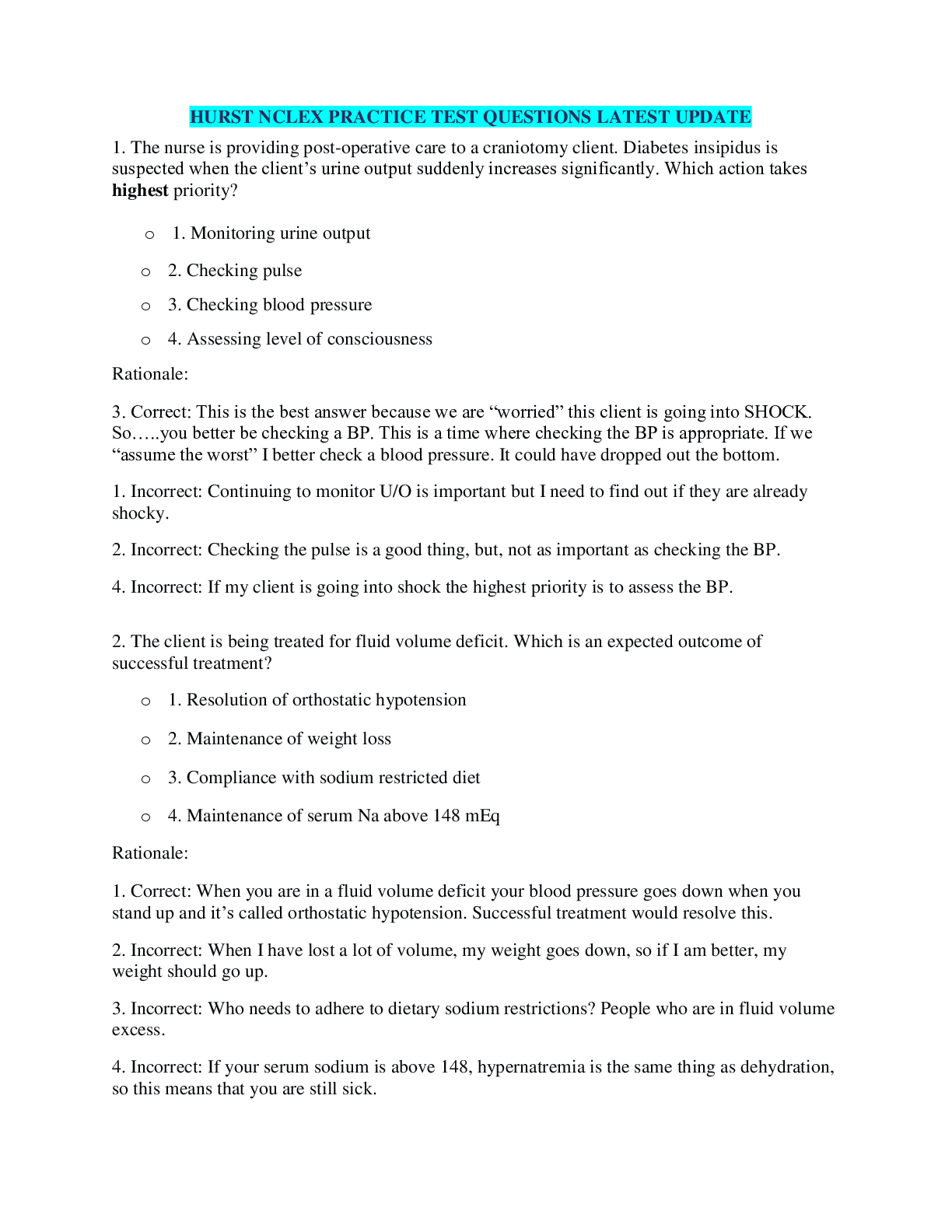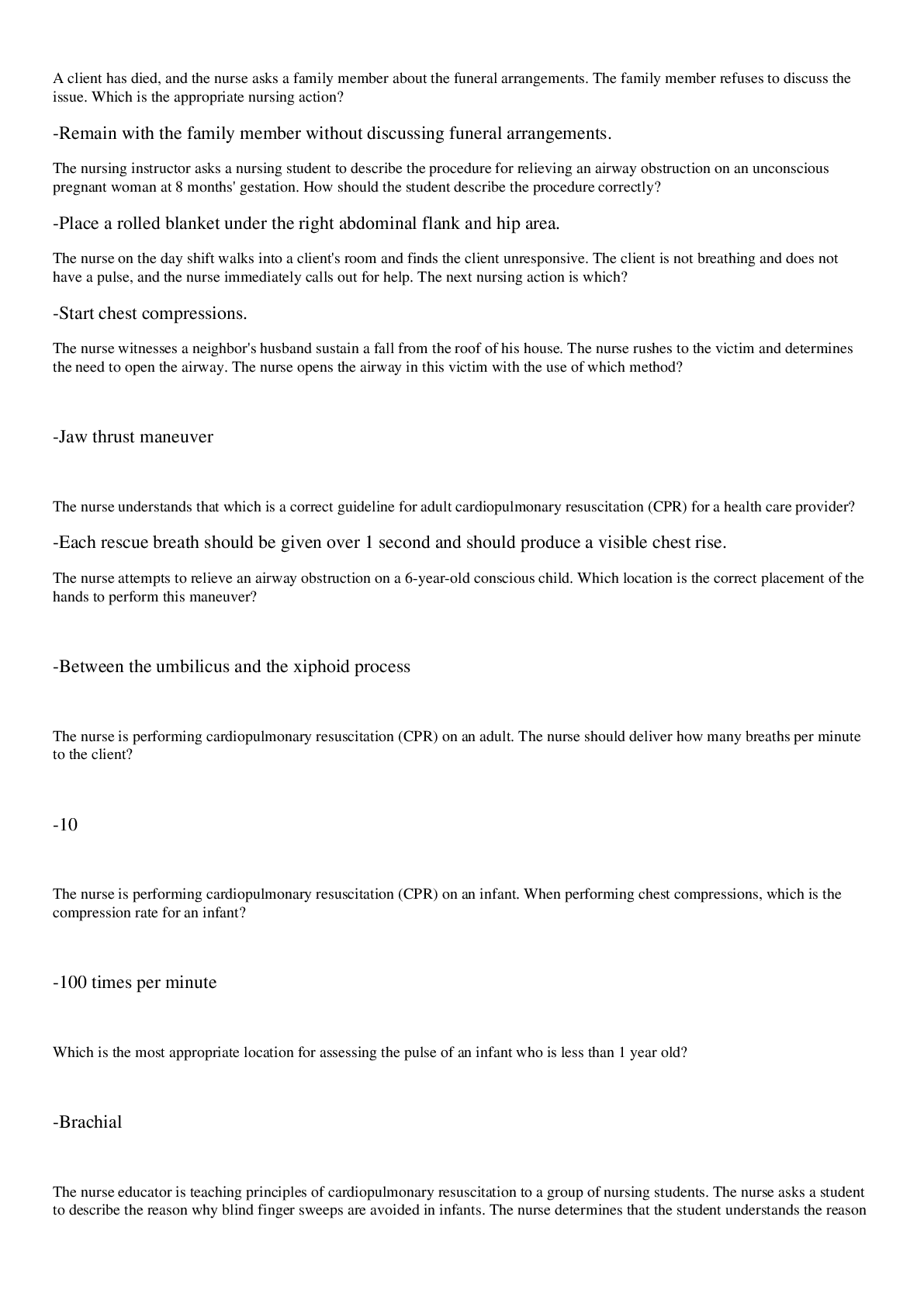*NURSING > NCLEX > NCLEX Nursing Fundamentals Module 8 Questions and answers {100%} | Nursing Fundamentals Module 8 {Gr (All)
NCLEX Nursing Fundamentals Module 8 Questions and answers {100%} | Nursing Fundamentals Module 8 {Graded A}
Document Content and Description Below
Module 8 NCLEX Questions NCLEX Nursing Fundermentals Module 8 Questions and answers – Keiser University 1. The nurse is preparing to administer digoxin, 0.125 mg orally, to a client with heart f... ailure. Which vital sign is most important for the nurse to check before administering the medication? A. Heart Rate B. Temperature C. Respirations D. Blood Pressure 2. The nurse is performing nasotracheal suctioning of a client. The nurse interprets that the client is adequately tolerating the procedure if which observation is made? A. Skin color becomes cyanotic. B. Secretions are becoming bloody. C. Coughing occurs with suctioning. D. Heart rate decreases from 78 beats/minute to 54 beats/minute. 3. The nursing student is asked to describe the correct steps for performing adult cardiopulmonary resuscitation (CPR). Arrange the steps of adult CPR in the order of priority. All options must be used. A. Determine unconsciousness by shaking the client and asking “Are you ok?” B. Perform chest compression C. Open the client’s airway D. Initiate breathing 4. The nurse monitors a postoperative client who had abdominal surgery for signs of complications. Which signs/symptoms should the nurse determine to be indicative of a potential complication? Select all that apply. A. Increasing restlessness B. A temperature of 98.9° F (37.7° C) C. Unrelieved pain despite receiving analgesicsModule 8 NCLEX Questions D. Faint bowel sounds heard in all four quadrants E. A blood pressure of 114/66 mm Hg with a pulse of 96 beats per minute 5. The nurse provides medication instructions to an older hypertensive client who is taking 20 mg of lisinopril orally daily. The nurse evaluates the need for further teaching when the client makes which statement? A. "I can skip a dose once a week." B. "I need to change my position slowly." C. "I take the pill after breakfast each day." D. "If I get a bad headache, I should call my health care provider immediately." 6. The nurse is caring for an older client who is on bed rest. The nurse plans which intervention to prevent respiratory complications? A. Decreasing oral fluid intake B. Monitoring the vital signs every shift C. Changing the client's position every 2 hours D. Instructing the client to bear down every hour and to hold his or her breath 7. The nurse assists with preparing a nursing care plan for a child who has Reye's syndrome. Which is the priority nursing intervention? A. Monitoring the output B. Checking pupillary responses C. Changing the body position every 2 hours D. Providing a quiet atmosphere with dimmed lights 8. The nurse is initiating seizure precautions for a child being admitted to the nursing unit. Which items are essential for the nurse to place at the bedside? A. Oxygen and a tongue depressor B. A suction apparatus and oxygen C. An airway and a tracheotomy set D. An emergency cart and an oxygen mask 9. The nurse is caring for a client after an autograft of a burn wound on the right knee. Which position should the nurse anticipate being prescribed for the client? A. Placing the affected leg flat B. Elevating and immobilizing the affected leg C. Immobilizing the client in a dependent positionModule 8 NCLEX Questions D. Placing the affected leg in a dependent position 10. The nurse is caring for a client after a mastectomy. Which nursing interventions should assist with preventing lymphedema of the affected arm? Select all that apply. A. Placing cool compresses on the affected arm B. Elevating the affected arm on a pillow above heart level C. Taking no blood pressure measurements in the affected arm D. Avoiding arm exercises during the immediate postoperative period E. Maintaining an intravenous (IV) insertion site below the antecubital area on the affected side 11. A client with cancer is receiving chemotherapy and develops thrombocytopenia. Which intervention is a priority in the nursing plan of care? A. Monitor the client for bleeding. B. Monitor the client's temperature. C. Ambulate the client three times daily. D. Monitor the client for pathological fractures. 12. Megestrol acetate, an antineoplastic medication, is prescribed for the client with metastatic endometrial carcinoma. The nurse reviews the client's history and contacts the registered nurse if which diagnosis is documented in the client's history? A. Gout B. Asthma C. Thrombophlebitis D. Myocardial Infarction 13. The nurse is monitoring the laboratory results of a female client receiving an antineoplastic medication by the intravenous (IV) route. The nurse plans to initiate bleeding precautions if which laboratory result is noted? A. A clotting time of 10 minutes B. A hemoglobin of 11 g/dL (110 mmol/L) C. A platelet count of 40,000 mm3 (40 × 109/L) D. A white blood cell (WBC) count of 3,000 mm3 (3 × 109/L)Module 8 NCLEX Questions 14. The client with non–Hodgkin's lymphoma is receiving daunorubicin. Which sign/symptom should indicate to the nurse that the client is experiencing a toxic effect related to the medication? A. Fever B. Diarrhea C. Complaints of nausea and vomiting D. Crackle on auscultation of the lungs 15. Which nursing action would be appropriate to implement when a client has a diagnosis of pheochromocytoma? A. Weigh the client B. Test the client’s urine for glucose C. Monitor the client’s blood pressure D. Palpate the client’s skin to determine warmth 16. The nurse is caring for a client with pheochromocytoma. Which data are indicative of a potential complication associated with this disorder? A. A urinary output of 50 mL/hr B. A congestion heard on auscultation of the lungs C. A blood urea nitrogen (BUN) level of 20 mg/dL 17. The nurse is caring for a client after a thyroidectomy and monitoring for signs of thyroid storm. The nurse determines that which sign/symptom is indicative that a thyroid storm may be occurring? A. Constipation B. Temperature of 96.6F C. Blood pressure of 80/60 mm Hg D. Heart rate of 44 beats per minute 18. A client with acquired immunodeficiency syndrome (AIDS) has histoplasmosis. Which sign/symptom should the nurse expect the client to experience? A. Dyspnea B. Headache C. Weight gain D. HypothermiaModule 8 NCLEX Questions 19. The nurse is taking the nursing history of a client with silicosis. The nurse checks whether the client wears which item during periods of exposure to silica particles? A. Mask B. Gown C. Gloves D. Eye Protection 20.The nurse is assisting in planning care for a client scheduled for insertion of a tracheostomy. Which equipment should the nurse plan to have at the bedside when the client returns from surgery? A. Obturator B. Oral Airway C. Epinephrine D. Tracheostomy tube with the next larger size 21. The nurse is caring for a client with an endotracheal tube attached to a ventilator. The high-pressure alarm sounds on the ventilator. The nurse prepares to perform which priority nursing intervention? A. Suction the client. B. Check for a disconnection C. Notify the respiratory therapist D. Evaluate the tube cuff for a leak 22.The nurse is preparing to obtain a sputum specimen from the client. Which nursing action is essential in obtaining a proper specimen? A. Have the client take three deep breaths. B. Limit fluids before obtaining the specimen. C. Ask the client to obtain the specimen after eating. D. Ask the client to spit into the collection container. 23.The emergency department nurse is caring for a client who sustained a blunt injury to the chest wall. Which sign noted in the client indicates the presence of a pneumothorax? A. Bradypnea B. Shortness of breathModule 8 NCLEX Questions C. A low respiratory rate D. The presence of a barrel chest 24.The nurse is caring for a client hospitalized with acute exacerbation of chronic obstructive pulmonary disease (COPD). Which should the nurse expect to note? A. Hypcapnia B. Hyperinflated lungs on chest x-ray C. Increased oxygen saturation with exercise D. A widened diaphragm noted on chest x-ray 25. The nurse has a prescription to give a client albuterol (two puffs) and beclomethasone dipropionate (two puffs) by metered-dose inhaler. How much time should the nurse place between administering the albuterol and then the beclomethasone dipropionate? A. 1 minute B. 2 minutes C. 5 minutes D. Administer immediately 26.A client with a prescription to take theophylline daily has been given medication instructions by the nurse. The nurse determines that the client needs further teaching about the medication if the client makes which statement? A. "I will take the daily dose at bedtime." B. "I will drink at least 2 L of fluid per day." C. "I will avoid over-the-counter (OTC) cough and cold medications unless approved by the PHCP." D. "I will avoid changing brands of the medication without primary health care provider (PHCP) approval." 27. A client has an Unna boot applied for treatment of a venous stasis leg ulcer. The nurse notes that the client's toes are mottled and cool, and the client verbalizes some numbness and tingling of the foot. Which interpretation should the nurse make of these findings? A. The boot has not yet dried. B. The boot is controlling leg edema. C. The boot is impairing venous return.Module 8 NCLEX Questions D. The boot has been applied too tightly. 28.A client has been diagnosed with Prinzmetal's angina. The nurse reviews the medical record and notes which accompanying characteristics? Select all that apply. A. Relieved by rest B. Occurs after exercise C. Prolonged severe pain D. Nitroglycerine relieves the pain E. Happens at the same time each day 29.The nurse is assisting in monitoring the condition of a client after pericardiocentesis for cardiac tamponade. Which observation indicates that the procedure was unsuccessful? A. Clear breath sounds B. Client expressions of relief C. Clearly audible heart sounds D. Distant and muffled heart sounds 30.The nurse is monitoring a client with an abdominal aortic aneurysm (AAA). Which finding is probably unrelated to the AAA? A. Pulsatile abdominal mass B. Hyperactive bowel sounds in the area C. Systolic bruit over the area of the mass D. Subjective sensation of "heart beating" in the abdomen 31. A client is scheduled for a dipyridamole thallium scan. The nurse should check to make sure that the client has not consumed which substance before the procedure? A. Caffeine B. Fatty Meal C. Excess Sugar D. Milk Products 32.A client with myocardial infarction (MI) has been transferred from the coronary care unit (CCU) to the general medical unit with cardiac monitoring viaModule 8 NCLEX Questions telemetry. The nurse assisting in caring for the client expects to note which type of activity prescribed? A. Strict bed rest for 24 hours B. Bathroom privileges and self-care activities C. Unrestricted activities because the client is monitored D. Unsupervised hallway ambulation with distances less than 200 feet 33.A client is being treated for acute heart failure with intravenously administered bumetanide. The vital signs are as follows: blood pressure, 100/60 mm Hg; pulse, 96 beats per minute; and respirations, 24 breaths per minute. After the initial dose, which is the priority assessment? A. Monitoring weight loss B. Monitoring temperature C. Monitoring blood pressure D. Monitoring potassium level 34.A client is diagnosed with pulmonary embolism and is to be treated with thrombolytic therapy. The nurse should report which priority data collection finding to the registered nurse before initiating this therapy? A. Adventitious breath sounds B. Temperature of 99.4° F orally C. Blood pressure of 198/110 mm Hg D. Respiratory rate of 28 breaths per minute 35. The nurse is assessing the patency of an arteriovenous fistula in the left arm of a client who is receiving hemodialysis for the treatment of chronic kidney disease. Which finding indicates that the fistula is patent? A. Palpation of a thrill over the fistula B. Presence of a radial pulse in the left wrist C. Absence of a bruit on auscultation of the fistula D. Capillary refill less than 3 seconds in the nail beds of the left hand 36.The client with chronic kidney disease who is scheduled for hemodialysis this morning is due to receive a daily dose of enalapril. When should the nurse plan to administer this medication? A. During dialysisModule 8 NCLEX Questions B. Just before dialysis C. The day after dialysis D. On return from dialysis 37. A client is admitted to the emergency department following a fall from a horse. The primary health care provider (PHCP) prescribes the insertion of an indwelling urinary catheter. The nurse notes blood at the urinary meatus while preparing for the procedure. Which action should the nurse take? A. Use a smaller catheter. B. Notify the primary health care provider. C. Administer pain medication before inserting the catheter. D. Use extra povidone-iodine solution in cleansing the meatus. 38.A client receiving nitrofurantoin calls the primary health care provider's office complaining of side effects related to the medication. Which side effect indicates the need to stop treatment with this medication? A. Nausea B. Diarrhea C. Anorexia D. Chest Pain 39.A client with chronic kidney disease is receiving epoetin alfa. Which laboratory result would indicate a therapeutic effect of the medication? A. Hematocrit of 32% B. Platelet count of 400,000 mm3 C. White blood cell count of 6000 mm3 D. Blood urea nitrogen (BUN) level of 15 mg/Dl 40.The nurse is planning to put aneurysm precautions in place for the client with a cerebral aneurysm. Which item should be included as part of the precautions? A. Limiting cigarettes to 3 per day B. Allowing out-of-bed activities as tolerated C. Allowing 1 cup of caffeinated coffee per day D. Maintaining the head of the bed at 15 degreesModule 8 NCLEX Questions 41. The nurse is caring for a client receiving morphine sulfate intravenously for pain. Because morphine sulfate has been prescribed for this client, which nursing action should be included in the plan of care? A. Encourage fluid intake. B. Monitor the client's temperature. C. Maintain the client in a supine position. D. Encourage the client to cough and deep breathe. 42.A client with a left arm fracture exhibits loss of sensation in the left fingers, pallor, slow refill, and diminished left radial pulse. The licensed practical nurse (LPN) should take which action? A. Administer an analgesic. B. Notify the registered nurse. C. Check the circulation again in 30 minutes. D. Provide range-of-motion exercises to the fingers of the left hand. 43.After a tonsillectomy, a child is brought to the pediatric unit. The nurse places the child in which appropriate position? A. Prone B. Supine C. High-Fowler’s D. Trendelenburg’s 44.The nurse is preparing to care for a client who will be arriving from the recovery room after an above-the-knee amputation. The nurse ensures that which priority item is available for emergency use? A. Surgical tourniquet B. Dry sterile dressings C. Incentive spirometer D. Over-the-bed trapeze 45. The nurse provides home care instructions to a client undergoing hemodialysis with regard to care of an arteriovenous (AV) fistula. Which statement by the client indicates an understanding of the instructions? A. "I should check the fistula every day by feeling it for a vibration." B. "I am glad that the laboratory will be able to draw my blood from the fistula."Module 8 NCLEX Questions C. "I should wear a shirt with tight arms to provide some compression on the fistula." D. "I should check my blood pressure in the arm where I have my fistula every week." E. The nurse instructs a client on pursed-lip breathing and asks the client to demonstrate the breathing technique. Which observation by the nurse indicates that the client is performing the technique correctly? 46.The nurse instructs a client on pursed-lip breathing and asks the client to demonstrate the breathing technique. Which observation by the nurse indicates that the client is performing the technique correctly? A. The client breathes in through the mouth. B. The client breathes out slowly through the mouth. C. The client avoids using the abdominal muscles to breathe out. D. The client puffs out the cheeks when breathing out through the mouth. 47. The nurse is assisting in collecting subjective and objective data from a client admitted to the hospital with tuberculosis (TB). The nurse should expect to note which finding? A. High Fever B. Flushed Skin C. Complaints of Weight Gain D. Complaints of Night Sweats 48.The nurse reinforces dietary instructions to a client who will be taking warfarin sodium. The nurse tells the client to avoid which food item? A. Grapes B. Spinach C. Watermelon D. Cottage Cheese 49.A client who has been receiving total parenteral nutrition by way of a central venous access device complains of chest pain and dyspnea. The nurse quickly assesses the client's vital signs and notes that the pulse rate has increased and that the blood pressure has dropped. The nurse determines that the client is most likely experiencing which sign?Module 8 NCLEX Questions A. Sepsis B. Air Embolism C. Fluid Overload D. Fluid Imbalance 50.The nurse provides instructions to a client about the use of an incentive spirometer. The nurse determines that the client needs further teaching about its use if the client makes which statement? A. "I need to sit upright when using the device." B. "I will inhale slowly, maintaining a constant flow." C. "I need to place my lips completely over the mouthpiece." D. "After maximal inspiration, I will hold my breath for 10 seconds and then exhale." 51. The nurse is monitoring a client with a closed chest tube drainage system and notes fluctuation of the fluid level in the water-seal chamber during inspiration and expiration. On the basis of this finding, which conclusion should the nurse make? A. There is a leak in the system. B. The chest tube is functioning as expected. C. The amount of suction needs to be decreased. D. The occlusive dressing at the insertion site needs reinforcement. 52. The nurse is providing morning care to a client who has a closed chest tube drainage system to treat a pneumothorax. When the nurse turns the client to the side, the chest tube is accidentally dislodged from the chest. After immediately applying sterile gauze over the chest tube insertion site which should the nurse do next? A. Replace the chest tube system. B. Obtain a pulse oximetry reading. C. Notify the registered nurse (RN). D. Place the client in Trendelenburg's position. 53. A pregnant client in the third trimester of pregnancy with a diagnosis of mild preeclampsia is being monitored at home for progression of the disease process. The home care nurse reinforces teaching the client about the signs that need to beModule 8 NCLEX Questions reported to the primary health care provider (PHCP) and tells the client to call the PHCP if which occurs? A. Urine output increases. B. Fetal movements are more than 4 per hour. C. Weight increases by more than 1 pound in a week. D. The blood pressure reading is between 122/80 and 138/88 mm Hg. 54. The nurse caring for a client who is receiving oxytocin for the induction of labor notes a nonreassuring fetal heart rate (FHR) pattern on the fetal monitor. On the basis of this finding, which is the nurse's priority action? A. Stop the oxytocin infusion B. Check the client’s blood pressure C. Check the client for bladder distention D. Place the client in a knee-chest position 55. The nurse reviews the arterial blood gas results of a client and notes that the results indicate a pH of 7.30, Pco2 of 52 mm Hg, and HCO3- of 22 mEq/L. Which interpretation should the nurse correctly make about these results? A. Metabolic Acidosis B. Metabolic Alkalosis C. Respiratory Acidosis D. Respiratory Alkalosis 56. The nurse is monitoring a client who is attached to a cardiac monitor and notes the presence of U waves. The nurse checks the client and then reviews the results of the client's recent electrolyte results. The nurse expects to note which electrolyte value? A. Sodium 135 mEq/L B. Sodium 140 mEq/L C. Potassium 3.0 mEq/L D. Potassium 5.0 mEq/L 57. Which cardiovascular sign should the nurse expect to note in a client with a diagnosis of hypocalcemia? A. Hypotension B. Increased Heart RateModule 8 NCLEX Questions C. Bounding Periperal Pulses D. Shortened QT interval on electrocardiogram 58.The nurse is reinforcing home care instructions to the mother of an infant who has just been found to have hemophilia. The nurse should instruct the mother to do which? A. Use aspirin for pain relief. B. Pad crib rails and table corners. C. Use a soft toothbrush for dental hygiene. D. Use a generous amount of lubricant when taking a temperature rectally. 59. A health care provider (HCP) writes a prescription for digoxin, 0.25 mg daily. The nurse teaches the client about the medication and tells the client that it is important to do which? A. Count the radial and carotid pulses every morning. B. Check the blood pressure every morning and evening. C. Stop taking the medication if the pulse is higher than 100 beats per minute. D. Withhold the medication and call the HCP if the pulse is less than 60 beats per minute. 60.The nurse is assisting in caring for a newborn with respiratory distress syndrome. Which initial action should the nurse plan to best facilitate bonding between the newborn and parents? A. Encourage the parents to touch their newborn. B. Identify specific caregiving tasks that may be assumed by the parents. C. Explain the equipment used and how it functions to assist their newborn. D. Give the parents pamphlets that will help them understand their newborn's condition. 61. A client has a prescription for continuous monitoring of oxygen saturation by pulse oximetry. The nurse performs which best action to ensure accurate readings on the oximeter? A. Apply the sensor to a finger that is cool to the touch. B. Apply the sensor to a finger with very dark nail polish. C. Ask the client to limit motion in the hand attached to the pulse oximeter.Module 8 NCLEX Questions D. Place the sensor distal to an intravenous (IV) site with a continuous IV infusion. 62.The nurse is checking a dark-skinned client for the presence of petechiae. Which body area is best for the nurse to check in this client? A. Sclera B. Oral Mucosa C. Soles of the foot D. Palms of the hand 63.A client in the postpartum unit complains of sudden, sharp chest pain. The client is tachycardic and the respiratory rate is increased, and the primary health care provider diagnoses a pulmonary embolism. Which interventions apply to the care of this client? Select all that apply. A. Administer oxygen. B. Monitor the blood pressure. C. Prepare to administer morphine sulfate. D. Prepare to start an intravenous (IV) line. E. Prepare to administer warfarin sodium. F. Place the client on bed rest in a supine position. 64.A client with angina pectoris is experiencing chest pain that radiates down the left arm. The nurse administers a sublingual nitroglycerin tablet to the client. The client's pain is unrelieved, and the nurse determines that the client needs another nitroglycerin tablet. Which vital sign is most important for the nurse to check before administering a second dose of the medication? A. Temperature B. Respirations C. Blood Pressure D. Radial Pulse Rate 65. A client who has just been told that she is pregnant asks a clinic nurse when the fetus's heart will be developed and beating. The nurse tells the client that the fetal heart is beating at what gestational week? A. Week 5 B. Week 6Module 8 NCLEX Questions C. Week 7 D. Week 8 66.The nurse is changing the neck ties on a tracheostomy tube. Which method is appropriate for the nurse to take? A. Apply the new neck ties securely before removing the old neck ties. B. Insert the obturator in the tracheostomy tube while the neck ties are changed. C. Ask the client to hold the tracheostomy tube in place while the nurse changes the neck ties. D. Remove the old ties, clean the site, and then apply the new ties while a second health care team member holds the tracheostomy tube. 67. The nurse is preparing to suction a client through a tracheostomy tube. The nurse should perform which actions when performing this procedure? Select all that apply. A. Preoxygenating the client before suctioning B. Applying suction for a period of no more than 15 seconds C. Moistening the catheter tip in sterile saline solution before suctioning D. Introducing the catheter into the tracheostomy tube using a sterile gloved hand E. Placing suction on the catheter while introducing the catheter into the tracheostomy tube 68.The nurse is told that an assigned client will have the chest tubes removed. The nurse plans to do which in preparation for the procedure? A. Clamp the chest tubes. B. Empty the drainage system. C. Disconnect the drainage system. D. Administer pain medication 15 to 30 minutes before the procedure. 69.The nurse is planning to suction a client through a tracheostomy tube. Which is the amount of time for application of suction during withdrawal of the catheter? A. 10 Seconds B. 25 Seconds C. 30 Seconds D. 35 SecondsModule 8 NCLEX Questions 70.A client is diagnosed with thrombophlebitis. The nurse should tell the client that which prescription is indicated? A. Bed rest with bathroom privileges only B. Bed rest keeping the affected extremity flat C. Bed rest with elevation of the affected extremity D. Bed rest with the affected extremity in a dependent position All questions came from NCLEX Saunder’s Study Guide [Show More]
Last updated: 1 year ago
Preview 1 out of 17 pages
Instant download
 Questions and answers – Keiser University.png)
Buy this document to get the full access instantly
Instant Download Access after purchase
Add to cartInstant download
Reviews( 0 )
Document information
Connected school, study & course
About the document
Uploaded On
Feb 16, 2021
Number of pages
17
Written in
Additional information
This document has been written for:
Uploaded
Feb 16, 2021
Downloads
0
Views
89

 Questions and answers – Keiser University.png)
 Questions and answers – Keiser University.png)
 Questions and answers – Keiser University.png)
 Questions and answers – Keiser University.png)
 Questions and answers – Keiser University.png)

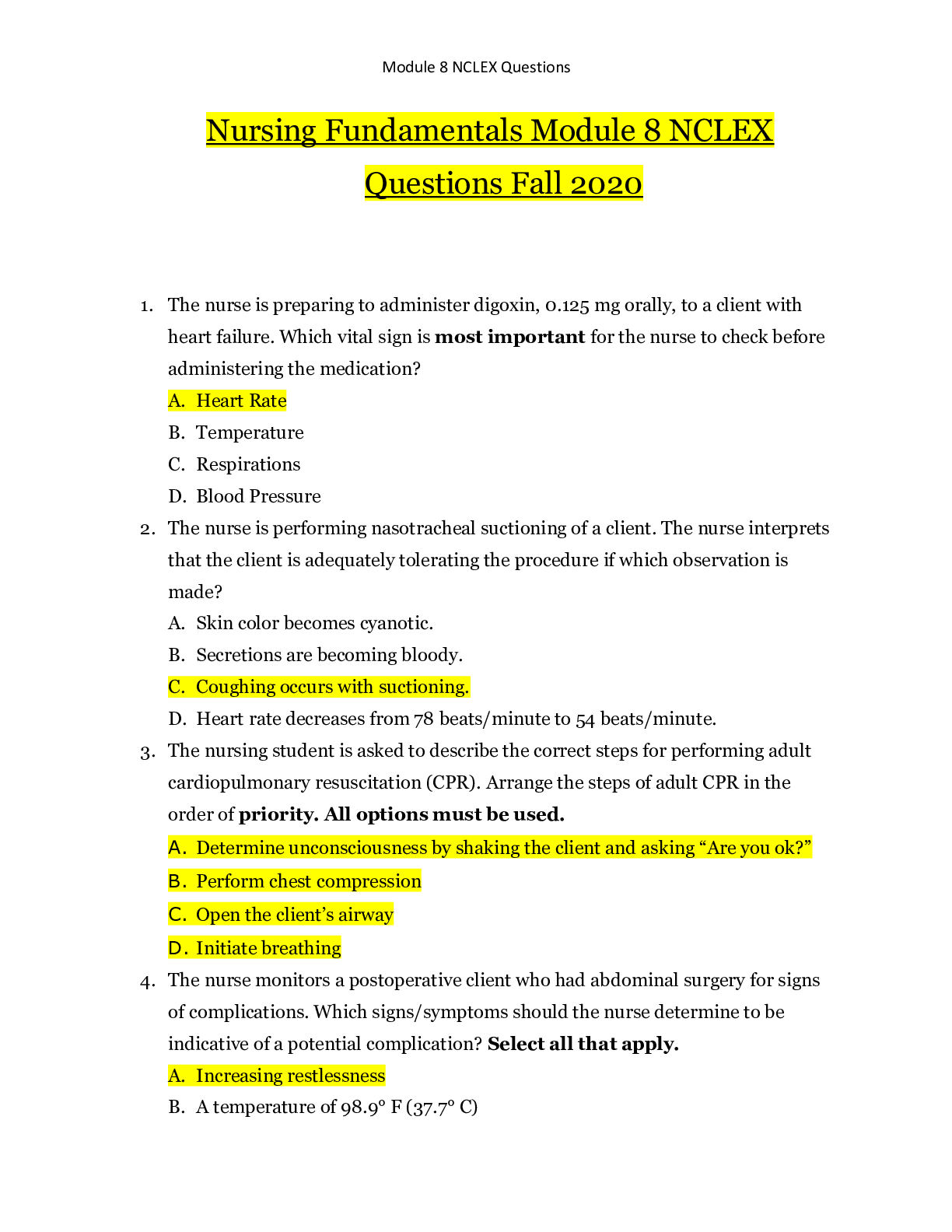

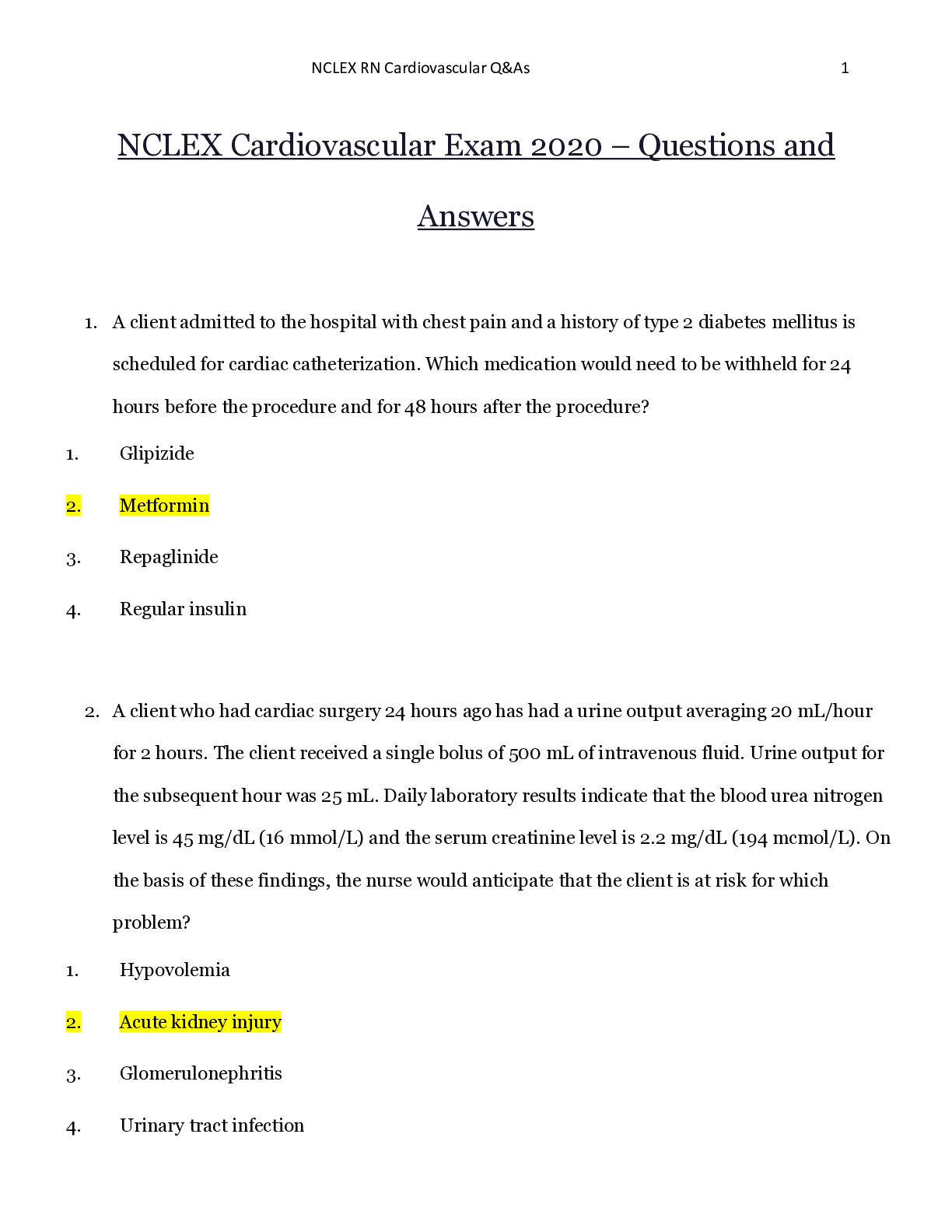
.png)

 NCLEX Study Guide Flashcards _ Quizlet-compressed.png)
